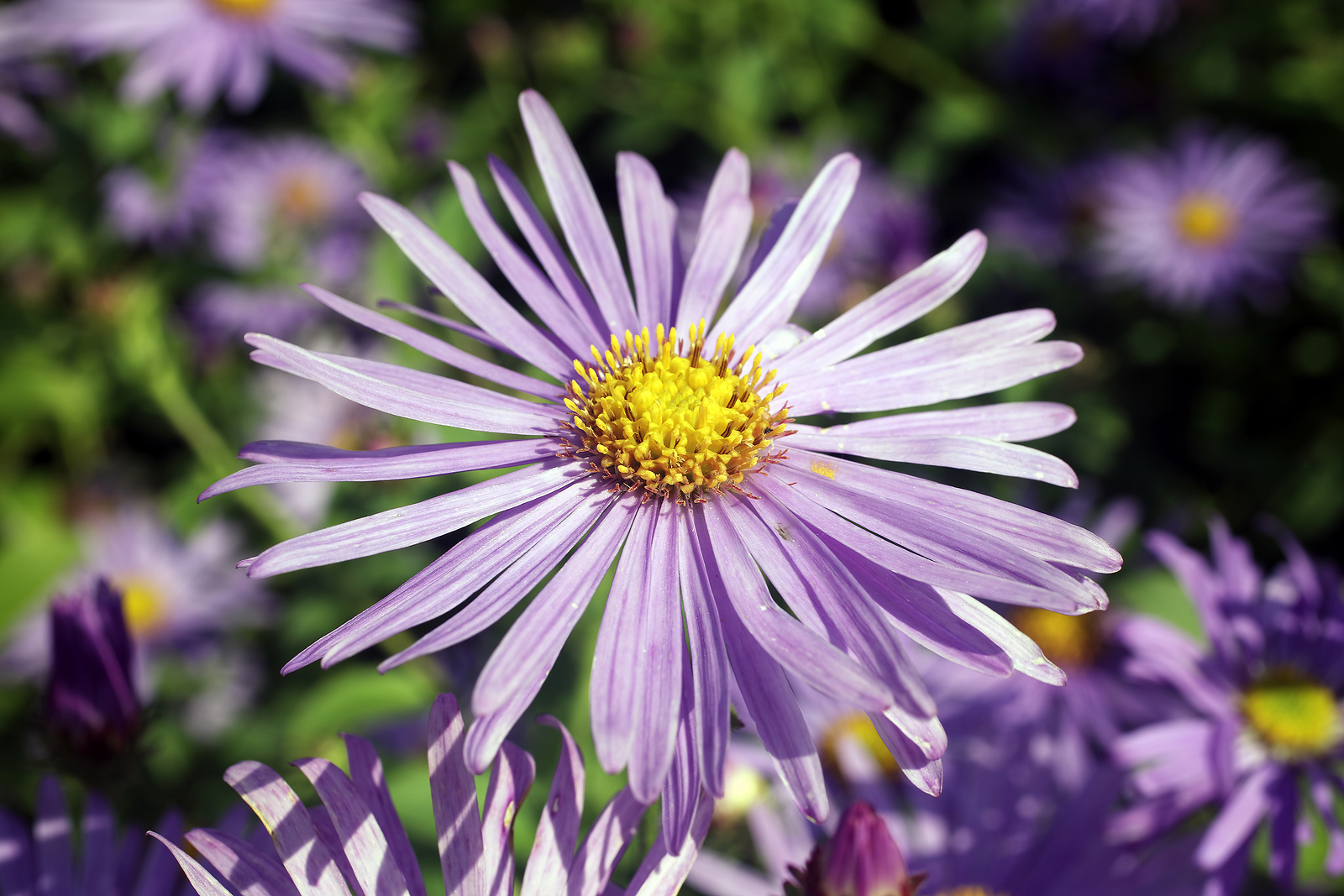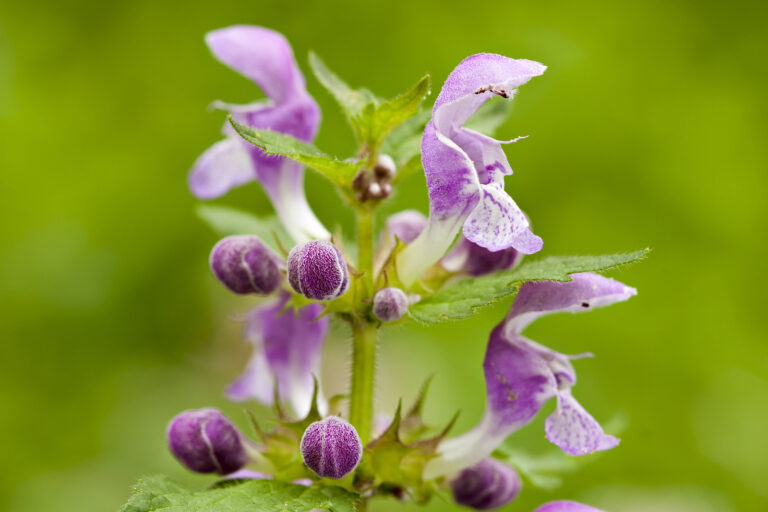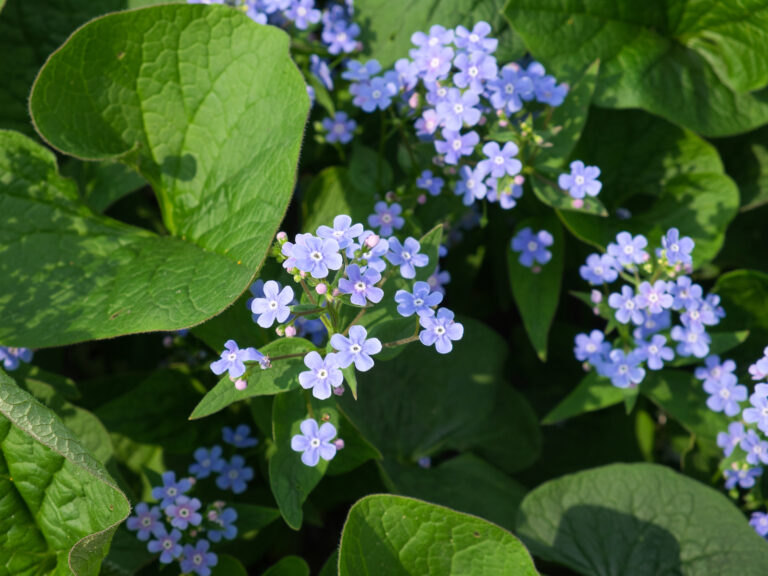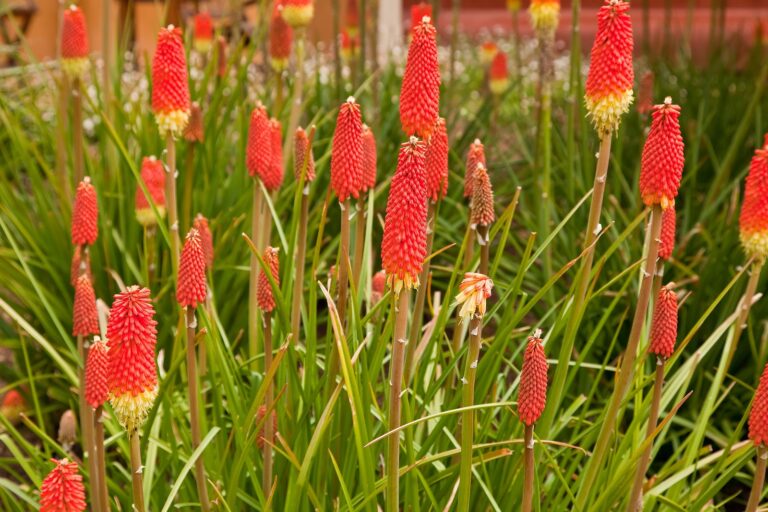How to Grow and Care for Asters
Garden asters form compact mounds of colorful blossoms—shades of blue, red, pink, lavender, or purple with bright yellow centers. Aster will brighten garden beds and borders and they are well-suited for container gardens. There are more than 600 species of asters; most are a foot or two tall but some grow to 6 feet tall and are widely branched.
Aster refers to two distinct genera of plants both of which are members of the Daisy family. Aster is the botanic name of true, hardy asters also called Starworts or Michaelmas Daisies many of which are native to the temperate zone of the United States. Secondly, Aster is the popular name of the tender, so-called China Asters, natives of China and Japan; these are among the most popular garden annuals. (The botanical name for China aster is Callistephus chinensis.)
Hardy asters are usually characterized by leafy stems and opposite, often spear-shaped leaves ranging from 1 to 4 inches in length. The small flowers are daisy-like with yellow or orange centers and fine, often thickly growing petals.
Good Products for Seed Starting Success at Amazon:
- Jump Start Germination Station w/Heat Mat Tray, 72-Cell Pack, Dome
- Espoma Seed Starting Mix
- 200 Count- Jiffy 7 Peat Soil Seed Starting Plugs
- Seed Starter Kit with Humidity Dome (120 Cells Total Tray)
- AgrobriteT5 Fluorescent, 2-Foot, Grow Light System
The colors range from deep purple to lavender, blue, pink, rose, and white. Most varieties bloom in late summer and fall when many other plants have finished blooming. This late blooming and variation in height from 6 inches to 6 feet make them suitable for many purposes in the garden.
Most aster cultivars like full sun. Many of them enjoy a moist situation though they do like their roots to sit in water. They usually accept average garden conditions with open exposure. Good average garden soil is best–not overly rich soil.
In the flower border, the taller varieties may be used as background flowers with smaller ones in front of them arranged according to their respective heights. Dwarf cultivars make ideal rock-garden plants.
Asters are easily raised from seed, usually blooming the next year after spring sowing.
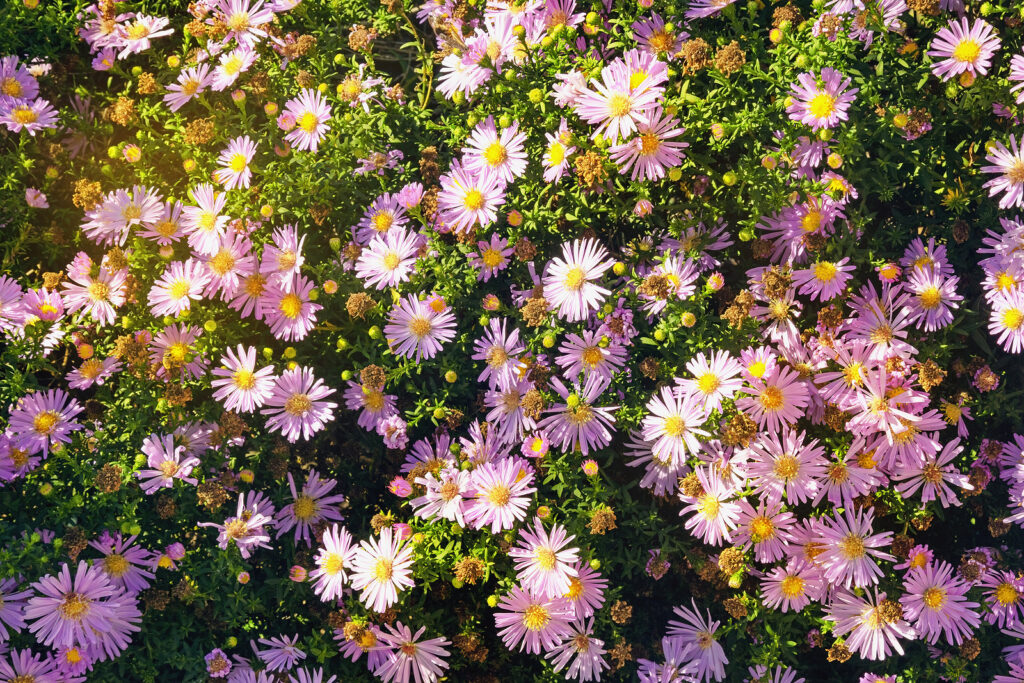
Get to know Asters
- Plant type: Perennial
- Growing Zones and range: Zones 4 to 9
- Hardiness: Asters grow well where fall is cool and moist; hardy in cold and hot weather.
- Height and width: 12 to 60 inches (30-152cm) tall; 12 to 36 inches (30-91cm) wide depending on the variety.
- Form: Plants form clumps of narrow leaves and send up branching spikes of daisy flowers; smaller hybrids form almost solid mounds of color
- Flower form: Ray-shaped flowers in many colors; flowers 1½ to 2 inches across
- Flower colors: Blue, violet, crimson, pink, white
- Uses: Perennial border
- Garden companions: Combine with other late-summer and fall perennials such as phlox, coneflower, sunflowers, Japanese anemone, and ornamental grasses.
- Bloom time: Mid-summer through fall.
- Common name: Michaelmas daisy, Frikart’s aster, New England aster
- Botanical name: Aster spp.
- Family: Asteraceae
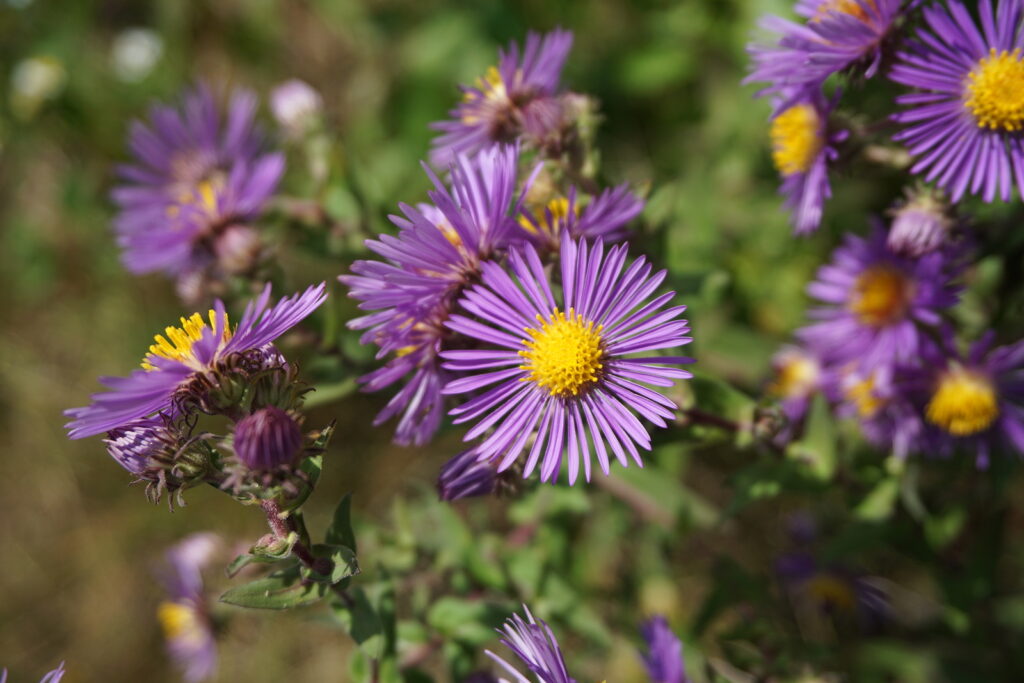
Where to plant Asters
- Asters grow best in full sun but will tolerate light shade.
- Grow asters in rich, well-drained but moist soil.
- Asters prefer a soil pH of 5.5 to 7.
Aster uses and companions
- Use Asters in borders, as a ground cover, beneath shrubs as edging in mixed borders.
- Good Aster companions are Anthemis tinctoria, Boltonia asteroides, Cimicifuga, Herocallis, Sedum ‘Autumn Joy‘, Solidago.
When to plant Asters
- Set out established plants in spring or fall.
- Start seeds indoors in spring.
- Sow seeds outdoors in early summer when temperatures are 70°F (21°C)
- Set plants outdoors from spring through fall.
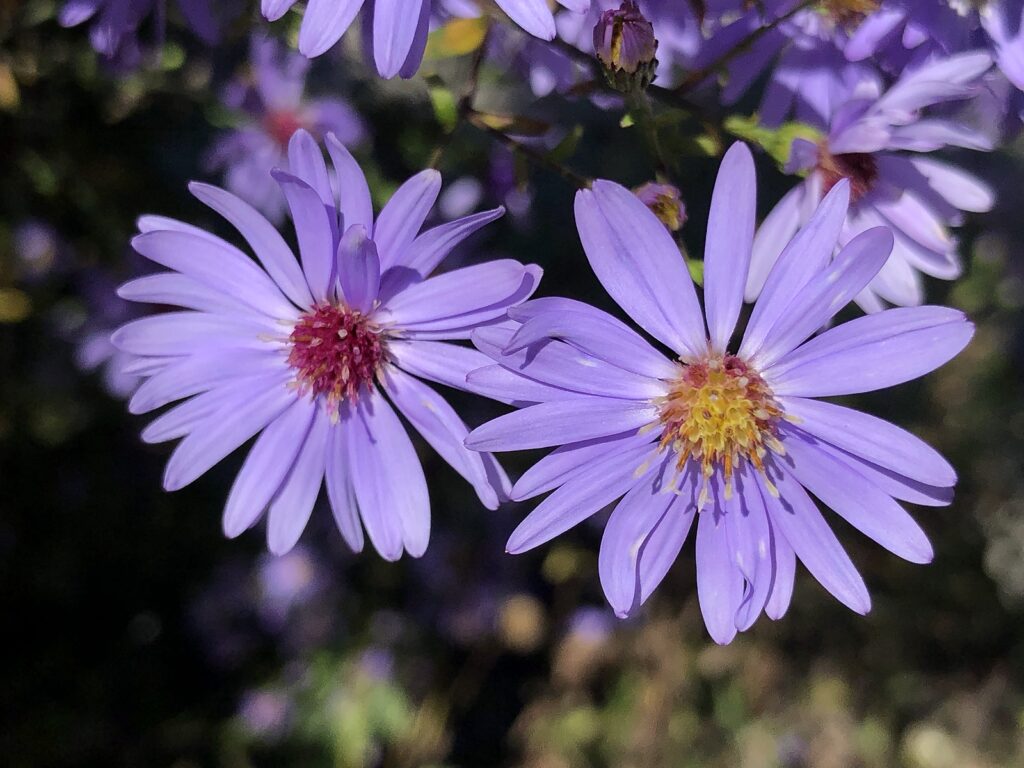
Planting and spacing Asters
- Start seed indoors in six-packs or pots; sow seed 1/8 inch deep; keep seed at 65°-75°F (18°-24°C). Keep seedlings in bright sunlight or directly below fluorescent light.
- Sow seed outdoors at about 70°F (21°C) and about 1/8 inch deep. When grown from seed, most types will bloom the following year.
- Thin seedlings when they are 2 inches (5cm) tall and transplanted to garden when they are 4 inches (10cm) tall.
- Plants can be set in the garden any time from spring to fall.
- Space asters 6 to 36 inches (15-91cm)t apart depending on the variety.
How to water and feed Asters
- Feed asters lightly if at all. Use an all-purpose fertilizer to side-dress established plants.
- Keep the soil evenly moist but not wet during the growing season.
- Avoid overhead watering which can spread fungal disease or plant disease-resistant cultivars.

Asters care
- Pinch taller varieties back by half in early summer to prevent flopping.
- Stake tall rangy plants as needed.
- Stake asters in Zone 4 and colder; they will be less compact but they will bloom before cold weather arrives.
- After cutting the plant back in autumn, heap dry leaves or straw mulch over the plant during winter.
- Mulch with aged compost or chopped leaves to conserve soil moisture.
- Trim back the tops when they turn brown.
- Protect asters in winter by mulching with chopped leaves.
Aster propagation
- Take stems cutting in spring.
- Divide asters in early spring or fall. Divide large clumps in half or thirds when growth begins in early spring; divisions should bloom the same year.
- New plants often grow from self-sown seeds.
Aster pests and diseases
- Plant asters in a well-drained location to deter root rot.
- Powdery mildew can turn leaves dull gray; space plants to promote air circulation; spray with sulfur.

Aster varieties to grow
- Aster alpinus. Dwarf, easy-to-grow, perennial, compact mounds with white, pink, and blue daisy-like flowers and gold centers.
- A. amellus. Italian aster, hardy, 2-foot-tall perennial, large violet flowers.
- A. x frikartii, Frikart’s aster, long-blooming perennial with purple flowers, easy to grow; hardy to -20°F (-29°C).
- A. cordifolius. Bluewood aster grows to 6 feet tall, tiny blue flowers in large loose bunches.
- A. ericoides. Heath aster, very hardy, white, blue, violet, or pink sprays of flowers; hardy to -40°F (-40°C).
- A. novae-angliae. New England aster, usually deep purple, very hardy, grows to 6 feet tall, many cultivars of this variety, with pink, white, rose, red, purple, or violet clusters; hardy to -30°F (-34°C).
- A. novi-belgii. (Symphyotrichum novi-belgii) New York aster, hardy in Zones 4-8.
- A. tanacetifolius (now Machaeranthera tanacetifolia). Tahoka daisy, annual with blue flowers, grows to 18 inches.
- A. tongolensis. ‘Bergarten’ is a cultivar; mat-forming rock garden perennial, blue-lilac flowers with orange centers.
Asters frequently asked questions
Q: What is the best way to grow asters?
A: Grow asters in full sun. Prepare the seedbed by forking over the soil and working in aged compost or organic commercial planting mix. Sow seeds 2 to 3 inches apart and one-quarter inch deep. Sow seeds in mid-spring after the last frost. Keep the seedlings well watered and transplant them to their final location after they have formed true leaves. Keep the soil just moist.
Q: Can I start asters indoors?
A: Yes. Start aster seeds indoors 8 to 10 weeks before the last frost. It’s best to stratify seeds in order to promote germination. Do this by planting seeds in moistened medium, cover with plastic wrap to retain moisture, and refrigerating them for two weeks. After removing them from the refrigerator, set them in a sunny place to germinate. They can be transplanted when they have three or four true leaves.
Q: Do you have tips for transplanting asters into the garden?
A: Asters can be transplanted to the garden after the last frost when they have three or four true leaves. Set the seedlings in the soil so that the bottom leaves are resting on the surface. Water well and apply mulch. When flowers appear, feed the plants with liquid fertilizer weekly.

